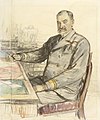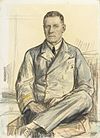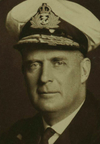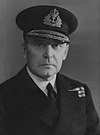
The Admiralty was a department of the Government of the United Kingdom responsible for the command of the Royal Navy until 1964, historically under its titular head, the Lord High Admiral – one of the Great Officers of State. For much of its history, from the early 18th century until its abolition, the role of the Lord High Admiral was almost invariably put "in commission" and exercised by the Lords Commissioner of the Admiralty, who sat on the governing Board of Admiralty, rather than by a single person. The Admiralty was replaced by the Admiralty Board in 1964, as part of the reforms that created the Ministry of Defence and its Navy Department.

The Second Sea Lord and Deputy Chief of Naval Staff is deputy to the First Sea Lord and the second highest-ranking officer currently to serve in the Royal Navy and is responsible for personnel and naval shore establishments. Originally titled Second Naval Lord in 1830, the post was restyled Second Sea Lord in 1904. They are based at Navy Command, Headquarters.

The post of Controller of the Navy was originally created in 1859 when the Surveyor of the Navy's title changed to Controller of the Navy. In 1869 the controller's office was abolished and its duties were assumed by that of the Third Naval Lord whose title then changed to Third Naval Lord and Controller of the Navy. In 1904 the title was changed again to Third Sea Lord and Controller of the Navy. In 1965 the office of the Third Sea Lord was abolished. The post-holder is responsible for procurement and matériel in the British Royal Navy.

The Fifth Sea Lord was formerly one of the Naval Lords and members of the Board of Admiralty that controlled the Royal Navy. The post's incumbent had responsibility for naval aviation.

The Navy Command is the current headquarters body of the Royal Navy, and as of 2012 its major organisational grouping. It is a hybrid, neither a command, nor simply an installation. Royal Navy official writings describe Navy Command Headquarters both as a physical site, on Whale Island, Hampshire, a collective formed of the most senior RN officers, and as a budgetary grouping.

The Assistant Chief of the Naval Staff (A.C.N.S.) is a senior appointment in the Royal Navy usually a two-star rank and has a NATO ranking code of OF-7.

The Vice Chief of the Naval Staff (V.C.N.S.) was a senior appointment in the Royal Navy usually a three-star rank and had a NATO ranking code of OF-8 that existed from 1941 to 1985 and was a member of the Admiralty Naval Staff.

The Deputy First Sea Lord (D.F.S.L.) was a senior Royal Navy flag officer on the Board of Admiralty of the Royal Navy.

The Admiralty War Staff was the former senior naval staff operational planning organisation within the British Admiralty that existed from 1912 to 1917. It was instituted on 8 January 1912 by Winston Churchill in his capacity as First Lord of the Admiralty and was in effect a war council whose head reported directly to the First Sea Lord. After the First World War ended, the War Staff was replaced by the Admiralty Naval Staff department.

The Admiralty Naval Staff was the former senior command, operational planning, policy and strategy department within the British Admiralty. It was established in 1917 and existed until 1964 when the department of the Admiralty was abolished. It was replaced by the Ministry of Defence as part of the Ministry of Defence Navy Department.

The Admiral of Patrols was a former command appointment within the Admiralty during World War I usually held by a junior flag officer the post was established from 1912 to 1916.

The Anti-Submarine Division its original name, was the former anti-submarine warfare, planning and prevention directorate of the Admiralty Department from 1912 to 1963.

The Naval Mobilisation Department also known as the Mobilisation and Movements Department was a former department of the British Admiralty initially from 1909 to 1912 and then again from 1918 to 1932. It was mainly responsible for plans, mobilisation and manning during the pre-World War I and post war period.

The Gunnery and Torpedo Division was the former Directorate of the Admiralty Naval Staff responsible for weapons policy making, development and assessing weapon requirements from 1918-1920.

The Additional Civil Lord of the Admiralty or formally the Office of the Additional Civil Lord of the Admiralty sometimes called the Department of the Additional Civil Lord of the Admiralty was a member of the Board of Admiralty first from 1882 to 1885 and then again from 1912 to 1919 who was mainly responsible for administration of contracts for matériel for the Fleet, supervision of the contracts and purchase department and general organisation of dockyards within the Admiralty.

The Department of the Director of Dockyards, also known as the Dockyard Branch and later as the Dockyards and Fleet Maintenance Department, was the British Admiralty department responsible from 1872 to 1964 for civil administration of dockyards, the building of ships, the maintenance and repair of ships at dockyards and factories, and the supervision of all civil dockyard personnel.

The Gunnery Division was a Directorate of the Admiralty Naval Staff of the Royal Navy responsible for the tactical use of naval weapons and the training of naval personnel in relation to operational requirements. It was established in 1920 when the Gunnery and Torpedo Division was separated into an independent Gunnery Division and Torpedo Division. It existed until 1964 when the Department of Admiralty was abolished and replaced by a new Ministry of Defence.

The Training and Staff Duties Division, later known as the Tactical and Staff Duties Division, was a directorate of the Admiralty Naval Staff of the Royal Navy responsible for the tactical use of naval weapons and the training of naval personnel in relation to operational requirements from 1917 to 1958.

The Admiral Commanding, Reserves, was a senior Royal Navy post that existed from 1875 to 1976.

The Naval Staff Directorate is a military staff directorate created in 1985 as the Directorate of Naval Staff Duties. The directorate was originally part of the British Ministry of Defence and is now under the Ministry of Defence as part of Navy Command. It is currently administered by the Commodore Naval Staff now based at MOD HQ.




















